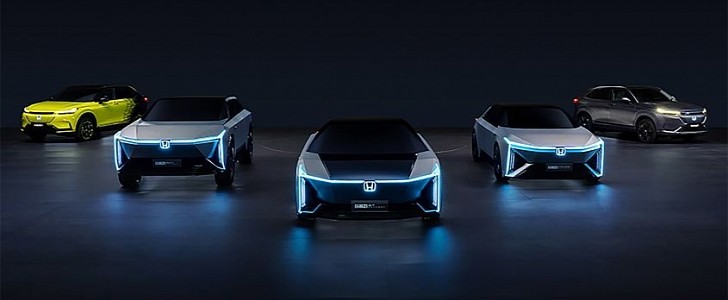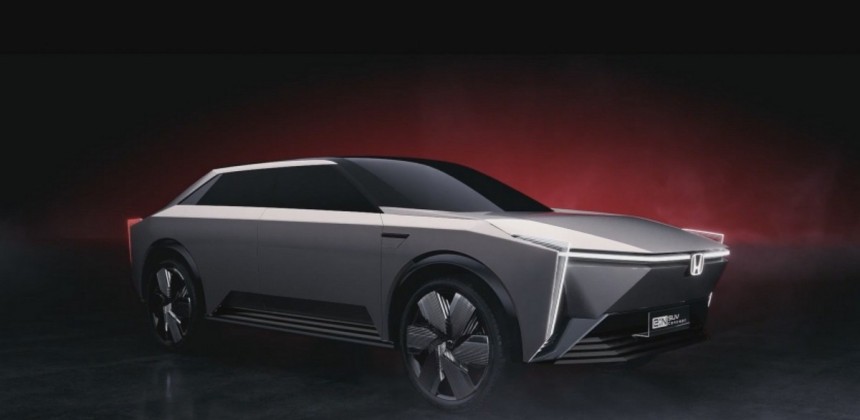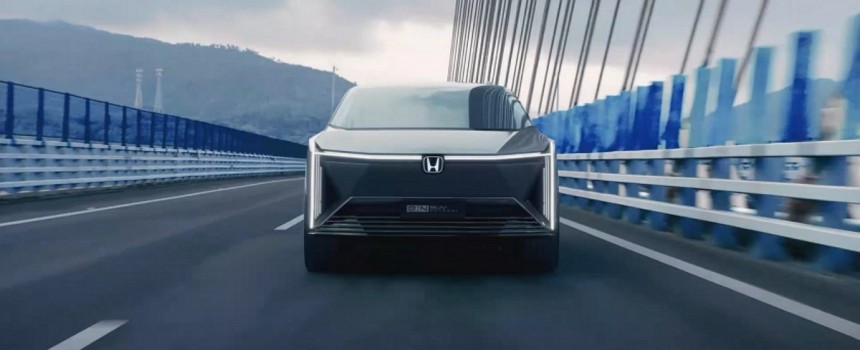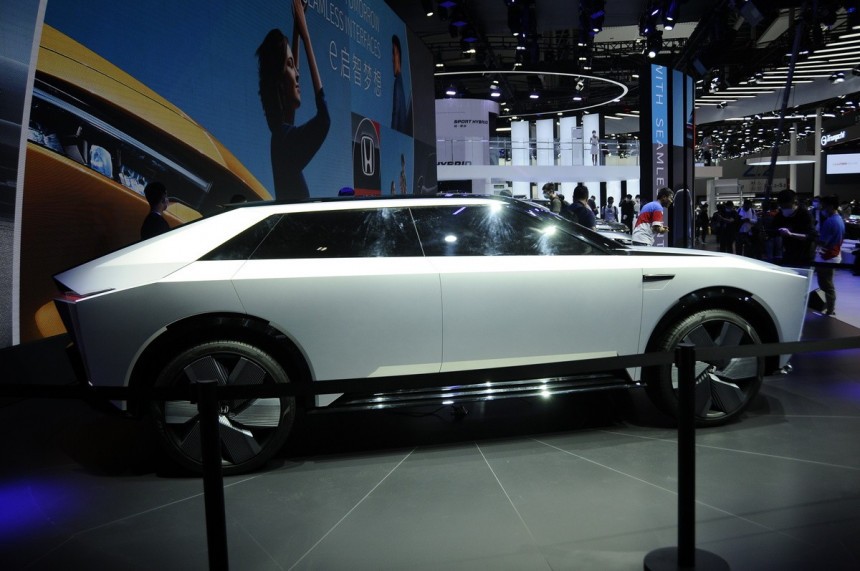Honda made a decisive step towards electric mobility when it launched the Honda e city vehicle, which was considered too expensive for the market, yet it managed to surprise with its high-tech features. But that was only the beginning of the carmaker's electrification effort.
China became a battleground between carmakers for production facilities and, moreover, it became a complex lab for developing electric cars and other advanced technologies. As a result, just like many other brands, Honda has created Chinese branches, including the Honda Technology Investment Co. Ltd., Guangqi Honda Automobile Co. Ltd., and Dongfeng Honda Automobile Co. Ltd., which jointly presented the Honda China Electrification strategy.
For starters, the group introduced the e:N brand on the market with not one, but five vehicles. While three of them are concept cars, the fourth model is a production electric SUV built in two versions. Moreover, the Japanese carmaker showed the e:N Architecture, which is more than just a platform with different wheelbases. It is adapted for different applications, with different powertrains, frames, and batteries.
It starts with the front-wheel drive platform named "e:N Architecture F," and it's dedicated to small and medium-sized vehicles. But these will also include SUVs, not only sedans or hatchbacks.
Those who want more from an electric car than just roaming in and around towns will have the e:N Architecture W. That will be available with either rear- or all-wheel drive systems. This platform is also the first to enter the assembly line for the newest Honda SUV named e:NP1, which was unveiled at the Guangzhou Motor Show as a production vehicle, after it was previewed as a concept car in April this year.
For vehicles fitted with the e:N Architecture W version, the carmaker offers a choice of one or two motors for the RWD and AWD versions, respectively. Inside the vehicle's floor, the carmaker will install a large-capacity, high-density battery that will ensure an ultra-long endurance, canceling range anxiety.
Another important step towards tomorrow's mobility is the infotainment unit, which relies on the e:N OS. This offers a new approach for the car-human connectivity, with an AI factor that will learn from its driver and, after a while, will provide useful information such as smart, economic routes, or nearest charging port when needed. It intends to be more a companion than just another touch-screen on the dash for playing music and talking on the phone.
The e:N OS integrates the Honda Sensing and the Honda Connect 3.0 features, and it aims to reduce and, moreover cancel, any accidents. Sure, it will take a while for that, and the carmaker admits that its target for zero traffic collision fatalities is 2050. However, while it looks like a very long shot, we must keep in mind that Honda never rushed its models on the market and never jumped to conclusions.
At the Guangzhou Motor Show, the carmaker introduced three unique-looking concept cars: the e:N COUPE, the e:N SUV, and the e:N GT. All three of them look like they were penned with a ruler in one hand and a straight-angle in the other. They might as well be named lo-res Hondas. But, of course, their shapes are not final, and they have a look to attract potential customers.
Honda named the design language of its three vehicles as e:N Design, which might not be that much inspired. Yet, it shows a distinct relationship between the three concepts thanks to the reversed-U shape light strip at the front that surrounds the polygonal shape of the front fascia. In addition, its triangular scoops and trapezoidal lower grille needed for cooling the batteries gave the carmaker more freedom of design expression. Judging by the look of the e:NS and the e:NP production vehicles, which resembles the JDM-spec Vezel, the final versions will feature rounded body panels.
But don't get spooked by the e:N SUV; it is not the concept car for the e:NP crossover. Instead, the former will be built upon an e:N Architecture W platform, while the latter is based on the F version, which means that the first Honda e:N production vehicle features a front-wheel drive system with one motor under the hood.
Due to safety regulations, its sharp edges and the extended transparent fins at the front cannot make it into production. The same goes with its tablemates, the GT, and the Coupe. Sure, all of them can carry up to five passengers, but they won't look like that. Also, we don't know if they will be autonomous or not, but they should get a Level 3 system, like the one fitted on the JDM Honda Legend flagship range and approved for use in Japan.
But we have to wait for at least two years and some change for the production vehicles, since the carmaker said it will have them on the assembly line starting with 2022. In advanced markets, including China, Honda's sales of pure electric vehicles and fuel cell vehicles are planned to account for 40% in 2030, 80% in 2035, and 100% in 2040.
This is just a new chapter for the Japanese carmaker of its electrification program. It started with the Chinese market, but soon they will be present in the U.S. and the rest of the world. But, unfortunately, most countries are not providing the legal framework for these vehicles to sell and use on the road an autonomous Level 3 system. By now, only Mercedes-Benz has gained international approval for its Drive Pilot system.
For starters, the group introduced the e:N brand on the market with not one, but five vehicles. While three of them are concept cars, the fourth model is a production electric SUV built in two versions. Moreover, the Japanese carmaker showed the e:N Architecture, which is more than just a platform with different wheelbases. It is adapted for different applications, with different powertrains, frames, and batteries.
It starts with the front-wheel drive platform named "e:N Architecture F," and it's dedicated to small and medium-sized vehicles. But these will also include SUVs, not only sedans or hatchbacks.
Those who want more from an electric car than just roaming in and around towns will have the e:N Architecture W. That will be available with either rear- or all-wheel drive systems. This platform is also the first to enter the assembly line for the newest Honda SUV named e:NP1, which was unveiled at the Guangzhou Motor Show as a production vehicle, after it was previewed as a concept car in April this year.
Another important step towards tomorrow's mobility is the infotainment unit, which relies on the e:N OS. This offers a new approach for the car-human connectivity, with an AI factor that will learn from its driver and, after a while, will provide useful information such as smart, economic routes, or nearest charging port when needed. It intends to be more a companion than just another touch-screen on the dash for playing music and talking on the phone.
The e:N OS integrates the Honda Sensing and the Honda Connect 3.0 features, and it aims to reduce and, moreover cancel, any accidents. Sure, it will take a while for that, and the carmaker admits that its target for zero traffic collision fatalities is 2050. However, while it looks like a very long shot, we must keep in mind that Honda never rushed its models on the market and never jumped to conclusions.
At the Guangzhou Motor Show, the carmaker introduced three unique-looking concept cars: the e:N COUPE, the e:N SUV, and the e:N GT. All three of them look like they were penned with a ruler in one hand and a straight-angle in the other. They might as well be named lo-res Hondas. But, of course, their shapes are not final, and they have a look to attract potential customers.
But don't get spooked by the e:N SUV; it is not the concept car for the e:NP crossover. Instead, the former will be built upon an e:N Architecture W platform, while the latter is based on the F version, which means that the first Honda e:N production vehicle features a front-wheel drive system with one motor under the hood.
Due to safety regulations, its sharp edges and the extended transparent fins at the front cannot make it into production. The same goes with its tablemates, the GT, and the Coupe. Sure, all of them can carry up to five passengers, but they won't look like that. Also, we don't know if they will be autonomous or not, but they should get a Level 3 system, like the one fitted on the JDM Honda Legend flagship range and approved for use in Japan.
This is just a new chapter for the Japanese carmaker of its electrification program. It started with the Chinese market, but soon they will be present in the U.S. and the rest of the world. But, unfortunately, most countries are not providing the legal framework for these vehicles to sell and use on the road an autonomous Level 3 system. By now, only Mercedes-Benz has gained international approval for its Drive Pilot system.






















